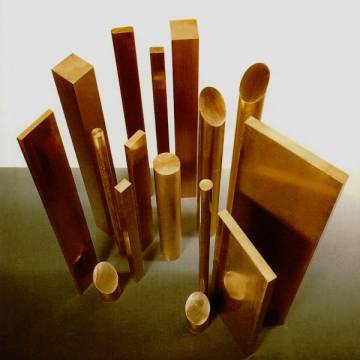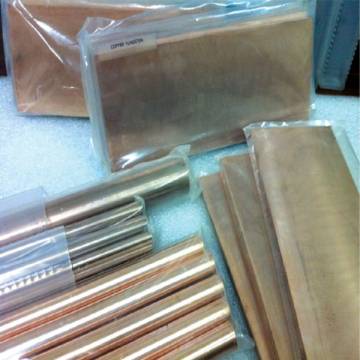Copper
Chromium Zirconium Copper (CuCrZr)
C18150 Copper Chromium Zirconium alloy offers a unique combination of strength, conductivity, heat resistance, and corrosion resistance, making it a valuable material for a wide range of demanding applications.
Specifications
- C18150
Summary
- Zirconium addition to chromium copper improves creep resistance at high operating temperatures and reportedly reduces sticking of electrodes to the work during spot welding of galvanized materials.
- Popular as moulds and dies for continuous casting due to its excellent electrical and thermal conductivity, hardness and ease of fabrication
- Low toxicity with excellent mechanical wear resistance and high radiation resistance
- Used extensively as electrodes in resistance welding and as circuit breakers in the electrical sector and also as rod extensions for seam and spot welding.
Introduction:
Properties of C18150 Copper Chromium Zirconium:
- High Strength: C18150 exhibits significantly higher strength compared to pure copper, enabling it to withstand heavy loads and mechanical stress without deformation or failure. This property makes it suitable for applications where structural integrity is paramount.
- Excellent Thermal Conductivity: Despite its alloying elements, C18150 retains good thermal conductivity, facilitating efficient heat dissipation in high-temperature environments. This characteristic is crucial for preventing overheating and maintaining component integrity.
- Heat Resistance: The addition of chromium and zirconium enhances C18150's resistance to elevated temperatures, allowing it to retain its mechanical properties and dimensional stability under extreme heat conditions. This feature makes it ideal for applications exposed to high temperatures, such as welding and hot forming tools.
- Corrosion Resistance: C18150 demonstrates good resistance to corrosion and oxidation, ensuring long-term durability and reliability in harsh operating environments.
- Machinability: While C18150 is generally more difficult to machine compared to pure copper, it remains machinable with the appropriate tools and techniques. Proper machining practices can yield precise components with tight tolerances.
- Weldability: C18150 can be welded using various methods, including resistance welding, brazing, and soldering, enabling the fabrication of complex assemblies and structures.
Applications of C18150 Copper Chromium Zirconium:
- Resistance Welding Electrodes: C18150 is commonly used in the manufacturing of resistance welding electrodes for spot welding, seam welding, and projection welding applications. Its high strength, heat resistance, and electrical conductivity ensure efficient energy transfer and consistent weld quality.
- Electrodes for Electrical Discharge Machining (EDM): C18150 is utilized as electrodes in EDM processes due to its excellent wear resistance, thermal stability, and electrical conductivity. It enables precise machining of intricate shapes in hardened materials.
- Hot Work Tooling: C18150 is employed in the production of hot work tooling components, such as dies, inserts, and punches, for forging, extrusion, and hot stamping operations. Its high strength and heat resistance allow for prolonged tool life and improved productivity.
- Mold Inserts: C18150 is used in injection molding and die casting applications to fabricate mold inserts and cores. Its thermal stability and wear resistance ensure dimensional accuracy and surface finish consistency in mass production processes.
- Aerospace Components: C18150 finds applications in aerospace engineering for manufacturing critical components subjected to high temperatures and mechanical loads, such as engine parts, heat exchangers, and aircraft structural elements.
Manufacturing Considerations:
- Alloy Composition: C18150 is typically produced by melting copper with precise amounts of chromium and zirconium to achieve the desired alloy composition and properties.
- Heat Treatment: Controlled heat treatment processes may be employed to enhance specific properties of C18150, such as strength, hardness, or machinability.
- Machining: Machining of C18150 requires specialized tools and cutting parameters due to its higher strength and hardness compared to pure copper. Proper lubrication and cooling are essential to minimize tool wear and achieve dimensional accuracy.
- Welding: Welding of C18150 requires suitable welding techniques and filler materials compatible with the alloy composition to ensure strong, defect-free joints.
Conclusion:








